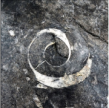Echinoderm
How to recognise them
Six-sided plates.
Fossil Info
Echinoderms are a family of animals that include starfish, sea urchins, sea cucumbers, and crinoids. They evolved in the Cambrian Period around 530 million years ago. Different echinoderm groups have been important in different time periods: crinoids were important in the Palaeozoic (before dinosaurs evolved) and sea urchins and starfish became more important after the end-Cretaceous mass extinction. Their skeletons are made of tiny thin polygonal (often hexagonal) plates made of calcium carbonate - the same mineral that makes up snail shells. They are unusual in having five-fold (pentameral) symmetry. All echinoderms have tiny tube feet for movement that stick out of tiny holes in their skeleton.
Fun Fact
Echinoderms get their food by scraping algae from rock surfaces in the oceans and were the first animals to evolve a body orifice (hole) used only for pooing!


